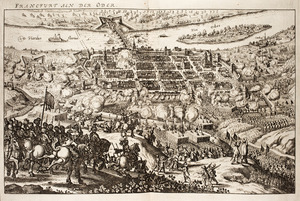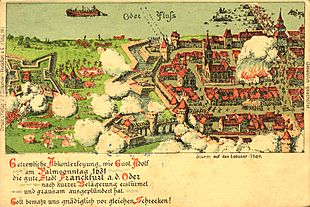Battle of Frankfurt an der Oder facts for kids
Quick facts for kids Battle of Frankfurt an der Oder |
|||||||
|---|---|---|---|---|---|---|---|
| Part of the Thirty Years' War | |||||||
 Battle of Frankfurt an der Oder by Matthäus Merian (1642) |
|||||||
|
|||||||
| Belligerents | |||||||
| Commanders and leaders | |||||||
| Strength | |||||||
| 18,000 | 6,400 | ||||||
| Casualties and losses | |||||||
| 800 killed or wounded | 1,700 killed | ||||||
The Battle of Frankfurt an der Oder happened on April 13, 1631. It was an important fight during the Thirty Years' War. This war was a long conflict in Europe.
The battle took place in Frankfurt an der Oder, a city in Brandenburg, Germany. This city was very important because it had a strong fort and a key crossing point over the Oder river. The battle was fought between the Swedish Empire and the forces of the Holy Roman Empire.
Sweden won the battle. This victory helped the Swedish army move further into Germany. It also protected their supply lines.
Why the Battle Happened
The Swedish king, Gustavus Adolphus, joined the Thirty Years' War in 1630. He landed his army in Pomerania, a region near the Baltic Sea. This gave Sweden a strong base in the northeastern part of the Holy Roman Empire.
Most of the empire was controlled by the Catholic League and Emperor Ferdinand II, Holy Roman Emperor. Many German Protestant states were unsure about joining Sweden. They did not fully trust Gustavus Adolphus at first.
In early 1631, Swedish troops moved south from Pomerania. They took over towns like Gartz (Oder) and Greifenhagen. These towns were close to the border of Brandenburg. On January 23, 1631, Sweden made an alliance with France. This agreement was called the Treaty of Bärwalde.
The Attack on Frankfurt
The Swedish army was led by King Gustavus Adolphus. They also had help from Scottish soldiers. These Scottish troops were commanded by John Hepburn and Robert Monro.
The Swedish forces surrounded Frankfurt an der Oder. They attacked the city for two days. On the second day, they stormed the city's defenses. The attack was successful. The Swedish army took control of the city.
One reason for their success was problems among the city's defenders. The soldiers defending Frankfurt were mercenaries, meaning they were paid fighters. They had not received their pay and refused to fight properly. Many defenders were killed during the attack. About 3,000 defenders died, while Sweden lost around 800 soldiers.
What Happened Next
After the battle, a Scottish general named John Leslie became the new governor of Frankfurt. He ordered the city's defenses to be made stronger. He also made sure that the many bodies were buried quickly. Large graves were dug for over a hundred bodies each. All the dead were buried within six days.
Later, two other Scottish officers, James MacDougal and Alexander Leslie, took over as governor of Frankfurt.
Frankfurt was important because it protected the Swedish army as they moved forward. Another major town nearby, Landsberg (Warthe) (now Gorzow), was captured by Sweden on April 23.
Because of these victories, George William, Elector of Brandenburg had to sign agreements with Sweden. These agreements gave Sweden control over Brandenburg's military. They were not a full alliance, but they helped Sweden.
Throughout 1631, King Gustavus Adolphus continued to advance into central Germany. Even though Magdeburg was lost in May, Sweden won a big victory at the Battle of Breitenfeld in September. This win opened the way for Sweden to move further into southern Germany.
Sources


